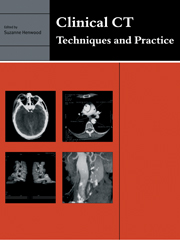CHAPTER 7 - The Pelvis
Published online by Cambridge University Press: 16 March 2010
Summary
Introduction
Computed tomography (CT) and ultrasound (US) remain the predominant imaging modalities for the pelvis, although this could change as magnetic resonance imaging (MRI) sequences continue to improve. CT remains both cheaper and faster than MRI of the pelvis, whilst also providing better bony definition in most instances. Ultrasound, whilst cheaper than a CT examination of the pelvis, has yet to circumnavigate the problems of gas within the bowel and of imaging requiring the information provided by the use of contrast media.
Many patients will in fact undergo both an ultrasound and a CT examination of the pelvis. Ultrasound is the modality of first choice in many instances; it is fast, mobile, relatively cheap and does not employ ionising radiation. However, a CT examination will provide information unobtainable from an ultrasound scan. CT is not adversely affected by gas in the bowel, and has a larger field of view allowing clearer visualisation of structures and organs in relation to one another. In addition, obese patients, who are notoriously difficult to scan satisfactorily with ultrasound, can be visualised very nicely using CT (as long as they fit into the scanner). Surplus fat within the pelvis actually serves to delineate and isolate structures within the pelvis (and abdomen) from each other.
The advent of helical CT in recent years has revitalised dynamic contrast enhanced CT imaging, with rapid scanning times providing valuable diagnostic information in such areas as tumour definition and vascular delineation.
- Type
- Chapter
- Information
- Clinical CTTechniques and Practice, pp. 95 - 112Publisher: Cambridge University PressPrint publication year: 1999



